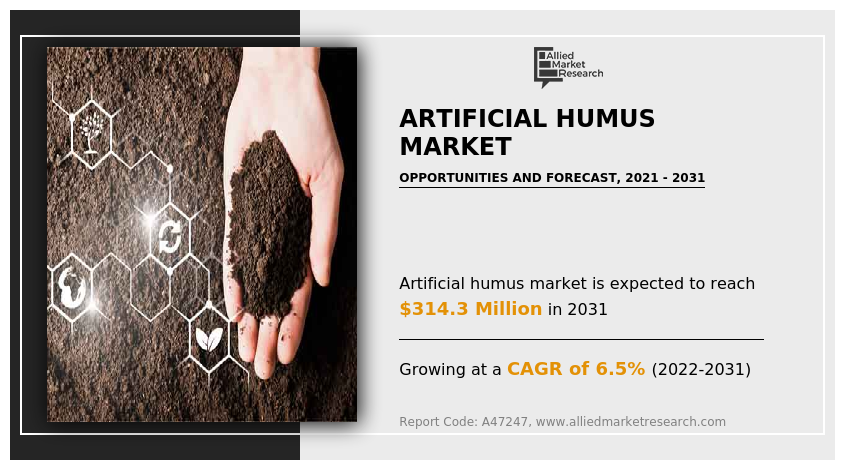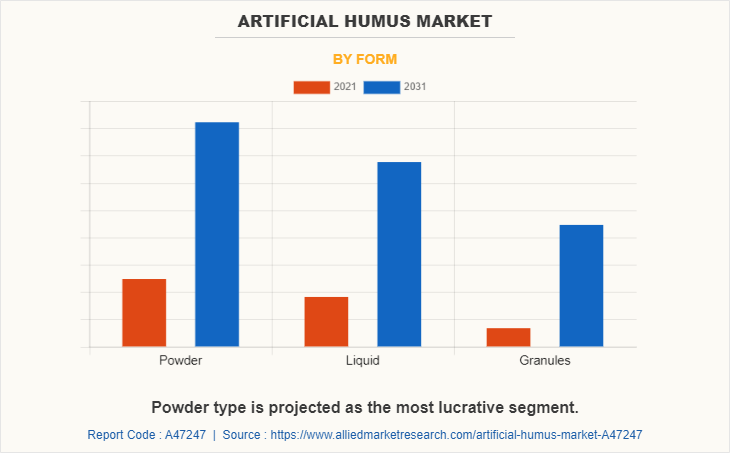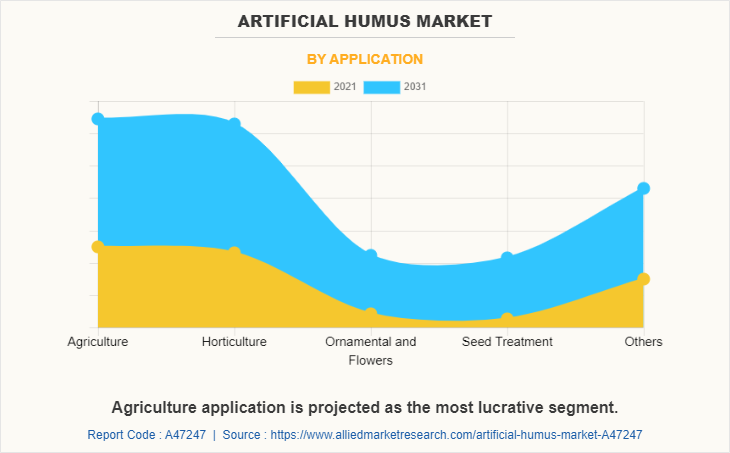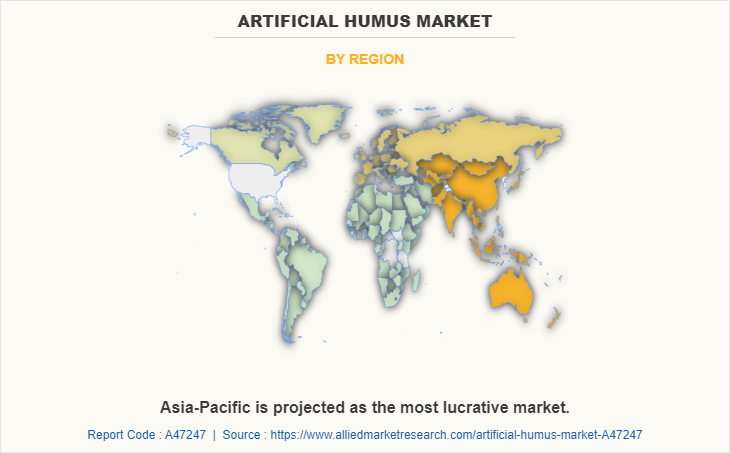Artificial Humus Market Research, 2031
The global artificial humus market was valued at $169.6 million in 2021, and is projected to reach $314.3 million by 2031, growing at a CAGR of 6.5% from 2022 to 2031.
KEY HIGHLIGHTERS
- The Artificial humus market has been analyzed in value. The value of the artificial humus market is analyzed in millions.
- Global Artificial humus market is fragmented in nature with many players such as Humusolver, The Fertrell Company, Ohio Earth Food, Novihum Technologies GmbH, Humintech, Organic Approach, LLC., Nature's Force Organics, Faust Bio-Agricultural Services, Inc., Nutri-Tech Solutions Pty Ltd. and Agbest Technology Co.,Ltd. Also tracked key strategies such as product launches, acquisitions, mergers, expansion etc. of various manufacturers of Artificial humus.
- Included more than 20 countries in the report which covers market volume as well as market value for all the countries of the artificial humus market.
- Covered the detailed list of manufacturers by application of the artificial humus market. It covers the product information, application, and geographical presence of the companies.
- Conducted primary interviews with raw material suppliers, wholesalers, suppliers, and manufacturers of the artificial humus market to understand the market trends, growth factors, pricing, and key players competitive strategies.

Artificial Humus is dark, organic material that forms in soil when plant and animal matter decays. Numerous beneficial nutrients for healthy soil can be found in humus. For most plants, nitrogen is a crucial nutrient which is present in humus. Humin, fulvic acid, and humic acid are the three primary elements of artificial humus concentration, along with bacteria, fungus, and algae that help the soil fix nitrogen. Biowaste is required to make artificial humus, such as green cuttings, leaf litter, or tree bark, which is humified to speed up the natural processes. As a result, a product mixture similar to naturally occurring humic substances is created, which can then be added to soils. Humic acid is a rich source of organic carbon and helps to maintain a hydrated, pH and redox buffered environment hosting the soil microbiome.
The main factor driving the use of artificial humus is the degrading soil quality. Soils are the basis of life and climate protectors. However, almost two billion hectares of arable and pasture land globally are affected by moderate to severe soil degradation as a result of overfertilization, deforestation, salinization, and overgrazing. As a result, there is a decline in groundwater quality, biodiversity, yields, and carbon dioxide sequestration. According to Intergovernmental Panel on Climate Change (IPCC) reports, a critical situation has already been reached by 2030.
Moreover, the rate of loss of rich soil is expected to be 24 billion metric tons per year, according to studies presented at a conference of the United Nations Convention to Combat Desertification (UNCCD) in the Ordos. Artificial humus plays a great role in preventing depletion of soil. It enhances water infiltration, which in turn helps in reducing surface runoff. In addition, soil with a high humus content has a solid soil aggregate that makes it difficult for the particles to be eroded by erosive forces like wind and water. Humus nourishes soil microbes including fungi, protozoa, bacteria, and algae as well as other species that help break down nutrients, such as earthworms and protozoa.
The population of the globe has increased over the past century and will keep expanding through 2030 and 2050. The rising global population resulted in increased food consumption. According to the Food and Agricultural Organization of the United Nations (FAO), the global food production will need to increase by 70% if the population reaches 9.1 billion by 2050. Due to the great advantages of artificial humus, it is used extensively in agricultural sector. Farmers all around the world will need to increase crop production, either by creating additional farming area or by boosting productivity on existing agricultural lands through irrigation, fertilizer, and use of artificial humus. When used in combination with fertilizer, humus significantly boosts crop yields. It also boosts crop yields overall as well as root development and total leaf area. The nutrient uptake of plants such as nitrogen, phosphorus, and iron, as well as innumerable trace elements essential for plant health is improved by using artificial humus.
Moreover, it enhances the physical appearance of fruit, vegetables, and flowers as well as their nutritional worth in the case of food crops. Cereal crops have demonstrated a higher protein content and a more balanced amino acid composition. Humic acid, which is biochemically active, helps strengthen a plant's natural defenses against pathogens and poisons. By bonding interactions with humic acids, numerous poisons are immediately inhibited or neutralized. In addition, the presence of biologically active substances in good humus, such as antibiotics and phenolic acids, can help plants resist various illnesses. Owing to these advantages of artificial humus, the demand for artificial humus market has grown tremendously.
The lack of awareness among farmers to use artificial humus is limited leading to hammering of markets’ growth. Farmers are not aware of the advantages artificial humus offers, instead they opt for synthetic fertilizers and other products. One of the most common methods for progressively increasing soil organic matter and enhancing soil biology is the use of compost or humic compounds. They are only used by a small percentage of farmers due to their diminished trustworthiness. Moreover, compost could introduce additional infections, pests, pathogen-like organisms, and undigested seeds to the soil. If manures were added, they can include dangerous bacteria and undigested weed seeds. Because of this, it forces farmers to use pesticides, harming the ecosystem. Owing to this factor, the growth of artificial humus is hampered to some extent.
The growing demand for organic fertilizers and biostimulants will present opportunities for the worldwide artificial humus market. Bio-stimulants are products that can reduce the need for fertilizers by increasing plant growth, abiotic stresses, and water resistance. Humic acid is essential for the production of bio-stimulants. The demand for humic acid will gradually increase the growth of artificial humus market. Moreover, there has been rise in sustainable agricultural practices which requires the usage of bio-stimulants. Hence, bio-stimulants and organic fertilizers have shown a great opportunity for the artificial humus market.
Benefits of artificial humus:
The availability of healthy soil is the backbone of any food system. A healthy soil is one that has organic material that has decomposed or is in the process of decomposing to produce humus. Furthermore, such soil produces healthy crops that in turn provide nourishment for the well-being of consumers. Both organic matter and minerals provide nutrition for crops. Humus is hence considered the backbone of crop production as it has a major role in their growth. Most soils used for agriculture contains approximately 2-10% of organic matter. And, even in such a small percentage, they are still very important. When synthetic humus is externally supplied, the soil's fertility is improved, resulting in a higher crop yield. This factor will drive the market growth during the forecast period.
Artificial humus offers many advantages such as it provides high nutrient supply, high water holding capacity, soil aggregation, prevents leaching & erosion, increases the oxidation of complex organic substances and others. Organic matter contains nutrients that are released after the breakdown by soil organisms. According to studies two to three pounds of sulfur, 4.5 to 6.6 pounds of phosphorus oxide and 20 to 30 pounds of the macro-element nitrogen are released by every percent of organic matter found in the soil. These elements released by the decomposed organic matter help in vegetative growth of a plant, amino acid production, support, anthocyanin formation, and chlorophyll production among other important functions that produce a healthy plant.
"Humus also nourishes the soil micro-organisms including fungi, protozoa, bacteria, and algae among other species such as earthworms and insects that create a living component (soil ecosystem) which aid in the breaking down of nutrients."
In addition, the soil needs enough moisture to remain healthy. In accordance with the needs of various crops, it must also have a good capacity for water retention. The soil's ability to hold onto water is facilitated by artificial humus. It functions like a sponge and can hold enough water to make up around 90% of its own weight. Thus, these advantages of artficial humus will drive the market growth during the forecast period.
High demand for artificial humus across various applications
Artificial humus is used for a variety of applications such as agriculture, horticulture, hydroponic, turf & meadow, landscaping, orchards, ornamental, vineyards, seed treatment and others. Artificial is humus used in organic horticulture, especially in greenhouses. The application of artificial humus products helps to prepare a desirable growing medium by providing good porosity, by increasing cation exchange capacity (CEC) and by improving biological activity. As a result, the growing medium is well aerated, roots can penetrate more easily, nutrients and water are better stored, pH is buffered against extreme ranges and salinity is reduced.
Furthermore, as hydroponic growing takes place in an enclosed environment, it is possible to cultivate plants with better use of resources and a minimum of waste. Humus from highly oxidized lignite, due to the chelation/complexation process, can enhance the availability of nutrients to hydroponics plants in the nutrient solution. This will continue stimulating plant growth, resulting in an earlier harvest with an increased yield.
Humus offers numerous advantages such as it influences several metabolic processes such as photosynthesis, respiration, nucleic acid synthesis and ion uptake in turf and meadow application. Artificial humus contains humic acid which influences the production of RNA, which is essential for many biochemical processes in the cell. Humic acid also stimulates the activities of some enzymes. Moreover, artificial humus often used in viticulture (vineyards) as it helps to restored soil fertility. The goal of this practice is to improve soil structure, soil biological activity, the ability to feed the plant and to increase the existence of competitive antagonists against soil-borne pathogens. Hence, wide application of artificial humus will drive the market growth during the forecast period.
The artificial humus market is segmented on the basis of form type, applications and region. On the basis of form type, the market is divided into powder, liquid and granules. Depending on the application, the market is classified into agriculture, horticulture, ornamental and flowers, seed treatment and others. Region wise, the market is analyzed across North America, Europe, Asia-Pacific and LAMEA.
The key players operating in the global artificial humus market are Humusolver, The Fertrell Company, Ohio Earth Food, Novihum Technologies GmbH, Humintech, Organic Approach, LLC., Nature's Force Organics, FAUST BIO-AGRICULTURAL SERVICES, INC., Nutri-Tech Solutions Pty Ltd. and AGBEST TECHNOLOGY CO.,LIMITED.

On the basis of form, the market is divided into powder, liquid, and granules. Powder form was the largest revenue generator, in 2021 and is anticipated to register a CAGR of 6.6% during the forecast period. Humus powder has a unique carbon matrix that includes a high concentration of trace minerals and organic acids. It enhances the plant's ability to take in essential nutrients and improves soil structure, these advantages of powder artificial humus are the major factors driving the growth of the artificial humus market over the projection period.

On the basis of applications, the global artificial humus market is divided into agriculture, horticulture, ornamental and flowers, seed treatment, and others. Agricultural was the largest revenue generator, in 2021 and is anticipated to expand at a CAGR of 6.6% during the forecast period. Owing to the advantages of humus, the production of crops is increased immensely to meet the demand for food globally. This in turn has boosted the growth of the artificial humus market.

Region-wise, the artificial humus market is analyzed across North America, Europe, Asia-Pacific, and LAMEA. The Asia-Pacific artificial humus market size is projected to expand at the highest CAGR of 6.8% during the forecast period owing to the increasing horticulture practices in the Asia-Pacific region has boosted the usage of artificial humus.
IMPACT OF COVID-19 ON THE GLOBAL ARTIFICIAL HUMUS MARKET
The COVID-19 pandemic is causing many victims worldwide and has generated a serious economic crisis. During COVID-19 pandemic, the companies were fronting obstructions due to intermittent supply chain activities and uncertain market conditions owing to trade restrictions and lockdowns. Substantial changes have occurred in the food and ornamental production chains.
Key Benefits For Stakeholders:
- This report provides a quantitative analysis of the market segments, current trends, estimations, and dynamics of the artificial humus market analysis from 2021 to 2031 to identify the prevailing artificial humus market opportunities.
- The market research is offered along with information related to key drivers, restraints, and opportunities.
- Porter's five forces analysis highlights the potency of buyers and suppliers to enable stakeholders make profit-oriented business decisions and strengthen their supplier-buyer network.
- In-depth analysis of the artificial humus market segmentation assists to determine the prevailing market opportunities.
- Major countries in each region are mapped according to their revenue contribution to the global market.
- Market player positioning facilitates benchmarking and provides a clear understanding of the present position of the market players.
- The report includes the analysis of the regional as well as global artificial humus market trends, key players, market segments, application areas, and market growth strategies.
Artificial Humus Market Report Highlights
| Aspects | Details |
| Market Size By 2031 | USD 314.3 million |
| Growth Rate | CAGR of 6.5% |
| Forecast period | 2021 - 2031 |
| Report Pages | 298 |
| By Form |
|
| By Application |
|
| By Region |
|
| Key Market Players | Humusolver, Nature's Force Organics, Organic Approach, LLC., Nutri-Tech Solutions Pty Ltd., The Fertrell Company, Novihum Technologies GmbH, AGBEST TECHNOLOGY CO.,LIMITED, Humintech, FAUST BIO-AGRICULTURAL SERVICES, INC., Ohio Earth Food |
Analyst Review
Major players in the artificial humus market are focusing on the needs of their customers, which has resulted in a high level of innovation in terms of the product high concentration of nitrogen, reservoir for nutrients and low cost. Additionally, the application of artficial humus is growing in a number of industries, including horticulture, seed treatment, ornamental & flowers, turf, among the others. The primary driver of market expansion is the growing application in the horticulture industry. However, the lack of awareness about artificial humus among the farmers is expected to restrain the market growth.
The industry is characterized by a high number of new market entrants that are seeking to tap lucrative opportunities in the global market while existing players are entering into strategic collaborations to increase capacities & expand their reach into emerging markets. Joint venture, merger, and acquisition activities in the industry have increased significantly over the past decade. Companies constantly seek to establish long-term contract agreements with trusted partners for sustainable business operations globally.
High demand for artificial humus across various applications is the key factor driving the global artificial humus market
Agriculture is the leading application of Artificial Humus Market
Asia-Pacific is the largest regional market for Artificial Humus.
The artificial humus market was valued for $169.6 million in 2021 and is estimated to reach $314.3 million by 2031, exhibiting a CAGR of 6.5% from 2022 to 2031.
The major players operating in the industry include Humusolver, The Fertrell Company, Ohio Earth Food, Novihum Technologies GmbH, Humintech, Organic Approach, LLC., Nature's Force Organics, FAUST BIO-AGRICULTURAL SERVICES, INC., Nutri-Tech Solutions Pty Ltd. and AGBEST TECHNOLOGY CO.,LIMITED. These players have adopted product launch, acquisition, and business expansion as their key strategies to increase their market shares.
Loading Table Of Content...



